NavSource Online: Submarine Photo Archive
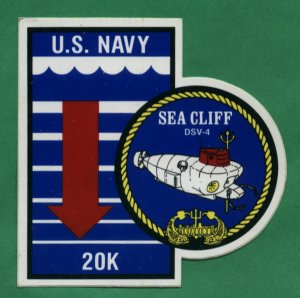
Patch contributed by Jack Treutle
Please report any broken links or trouble you might come across to the Webmaster.
Please take a moment to let us know so that we can correct any problems and make your visit as enjoyable and as informative as possible.

| Click On Image For Full Size | Size | Image Description | Source | |
|---|---|---|---|---|
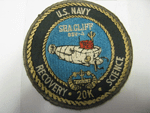 |
391k | Circa 1970-80 Sea Cliff (DSV-4) patch. It is available for sale by him @ larryshon1@gmail.com. |
Photo courtesy of Larry Beaver. | |
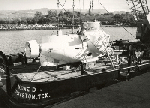 |
57k | U.S. Navy Deep Submergence Vehicle Sea Cliff (DSV-4) and her support vessel Maxine D, October 1971. | USN photo & text courtesy of USNI. | |
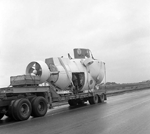 |
208k | Sea Cliff (DSV-4) is being transported to the Mare Island industrial area on 3 November 1972 at the start of her overhaul. This overhaul started on 1 November 1972 and completed on 30 June 1973. Note that her batteries are removed. | USN photo courtesy of the Vallejo Naval & Historical Museum via Darryl L. Baker. | |
 |
42k | Postal cover marking the dive of the Sea Cliff (DSV-4), 14 September 1973. | Courtesy of Jack Treutle (of blessed memory). | |
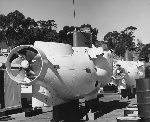 |
68k | Turtle (DSV-3) and Sea Cliff (DSV-4) dockside. Photo was taken in San Diego, Ballast Point prior to 10/19/73 since the same image appeared in the 10/12/73 edition of Mare Island’s Grapevine. | USN photo courtesy of San Francisco NARA, "Mare Island Naval Shipyard, Ship Files" & submitted by Tracy White @ Researcher @ Large. | |
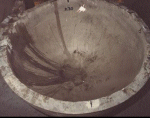 |
29k | One of the two hemispheres of the Sea Cliff (DSV-4) as received from RMI. Titanium plate about 4 inches thick was forged into the hemispheres. Note; as received, there were many cracks on the surface of the hemispheres, some about an inch deep. The cracks from the forging process were deeper than we thought they would be and there was some concern that the cracks would not be completely removed during machining. The hemispheres were machined both inside and outside to the correct shape, but were left oversize to allow for any distortion during welding. |
Photo & text courtesy of Jim Richardson. | |
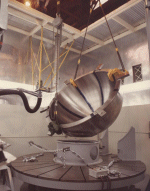 |
68k | One of two titanium hemispheres of the Sea Cliff (DSV-4) being lowered into the welding facility, basically a clean room. The TITANS Project of the early 70's explored the possibility of welding thick sections of titanium materials outside of a chamber. As a result of this project, two titanium spheres were fabricated from 1.92" thick 6Al-2Cb-1Ta-0.8Mo titanium alloy. One sphere was sent to the David Taylor Researcher Center for extensive testing. The other was installed to the deep submersible Alvin(DSV-2) which increased its operational depth from 7,500 feet to 13,125 feet. Initially designed and build by Electric Boat Division of General Dynamics Corporation at Groton, Connecticut, Sea Cliff (DSV-4) and her sister submersible Turtle (DSV-3) were launched on 11 December 1968. Both vehicles had personnel spheres of HY100 steel, vehicle frames of aluminum and were capable of depths of 7,500 feet. During an extensive overhaul, Turtle was later up-dated to an operational depth of 10,000 feet. This was accomplished by installing the sphere that was in Alvin. In June 1983, Sea Cliff began an extensive conversion at Mare Island Naval Shipyard, in Vallejo, California, that would last 7 months. The conversion included the detailed design and qualification of each system and component on the submersible for service to a depth of 20,000 feet. The personnel sphere at 20,000 feet will see a pressure of 8800 pounds per square inch and the sphere will not deform in anyway. Sea Cliff now features a titanium personnel sphere (2.87 inches thick 6Al-2Cb-1Ta-0.8Mo titanium alloy and is about 6.5 feet in diameter.) the personnel sphere is mounted in a 6AL-4V titanium alloy vehicle frame. The upgraded Sea Cliff would be 4.5 feet longer, now measuring 31 feet in length, by 10.5 feet wide and 12.5 feet high and 58,000 pounds. Sea Cliff, with her crew of three and capable of diving to 20,000 feet will have access to 98% of the world's ocean floor. This inner-space ship is capable of exploring an area roughly six times the surface area of the moon. Sea Cliff is used primarily for deep ocean object recovery, search and scientific research. Sea Cliff is classified as a "manned, non-combatant, untethered submersible". Sea Cliff is powered by silver-zinc batteries that energize her electrical systems and side-pod propulsion units. These side-pods are trainable through 360 and provide exceptional maneuverability. The batteries also energize two hydraulic power units that power the stern propulsion unit for cruising along the sea floor as well as a variety of other functions. Her life support system has an endurance that far exceeds the 16 hour mission profile. Sea Cliff became fully operational in 1984 and relieved Trieste II (DSV-1) as the nation's deepest diving vehicle. Trieste II is now on permanent display at the Naval Undersea Museum at Keyport WA. A little history on Alvin: In 1964, General Mills/Litton Industries, Minneapolis Minn. under contract to the U.S. Navy, built the deep submersible capable of diving 7,500 feet. Alvin's personnel sphere was fabricated from HY100. Alvin's personnel sphere was upgraded to titanium in the mid 1970's. Alvin is operated by Woods Hole Oceanographic Institution. In 1966 an American bomber collided with its tanker during in-flight refueling off the southern coast of Spain. Four of the five H-bombs on board the bomber fell harmlessly on land and were recovered. The fifth fell into the sea and initiated another Thresher-type operation to find and retrieve the 1.1 megaton bomb. Alvin located the parachute shrouded bomb on the ocean floor at 2,250 feet and attached a lift line which broke during retrieval and started the search anew. When the bomb was relocated, it was now at 2,850 feet. A remotely operated vehicle (ROV) was used to attach another lift line, in the process of hooking up the lift line the ROV became entangled in the bomb's parachute. The bomb and the ROV were retrieved, thus ending 80 days of search/recovery efforts. In 1968, a near-tragic event occurred a few hundred miles off Cape Cod. In the process of launching Alvin, a lift cable on Alvin's cradle snapped and Alvin fell into the sea and sank 5,500 feet to the ocean floor. Miraculously, the crew scrambled out before the vehicle sank. The following summer, the Aluminaut was able to put a lift hook on Alvin's open hatch and Alvin was pulled back to the surface. The Aluminaut has a design depth of 15,000 feet. Whereas most submersibles are made of steel, this one was made of aluminum. Too large to be transported by a mother ship, Aluminaut must be towed to the diving site. One of the largest submersibles, she could carry a crew of six for three days. A little history on Trieste II: In 1962 the U.S. Navy undertook the development of an improved bathysphere. This project was sponsored by the Naval Electronics Laboratory in San Diego CA and resulted in the construction of Trieste II. The design and construction was accomplished by Mare Island Naval Shipyard in Vallejo, CA. Reliability and safety were fundamental requirements. Trieste II was designed to carry either the Terni (20,000 ft.) or the Krupp (36,000 ft) sphere. The propulsion system, which consisted of two electric motors delivering 5 horsepower each to the propellers, provided an endurance of 8 hours at 2 knots using lead-acid type batteries. Interesting facts about a bathysphere as compared to submersibles and submarines: Unique Engineering Problems: For the submerged condition, the equilibrium of a bathysphere is governed by the well known principle of Archimedes relating weight and displacement. Many conventional submarine design techniques are applicable to a bathysphere but there are a number of unique engineering considerations. The basic difference between submersibles, submarines and a bathysphere is that most of the submersibles submarine's buoyant volume is made up of air while the buoyant volume of a bathysphere is principally a light weight liquid, such as aviation gasoline. While a submarine's volume is affected to a degree by pressure, the bathysphere's buoyant volume is affected more significantly. This requires vigilance on the part of the designer to anticipate all effects of pressure. For example: At 36,000 feet submerged, the gasoline in a buoyancy tank is reduced by 10%. At the same depth, salt water is compressed 5% and the densities are affected proportionately. Submersibles Sphere Thickness Material Max Depth Trieste II (DSV-1) HY120 5.94" 36,000' Alvin (DSV-2) Ti 1.92" 12,000' Turtle (DSV-3) HY100 1.33" 10,000' Sea Cliff (DSV-4) Ti 2.87" 20,000' |
Photo & text courtesy of Jim Richardson. | |
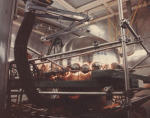 |
48k | The personnel sphere of the Sea Cliff (DSV-4) being preheated prior to welding. Thick section titanium required a preheat of 200°F prior to welding. | Photo & text courtesy of Jim Richardson. | |
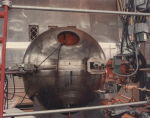 |
49k | This photo shows the automatic hot wire GTAW process used to join the two hemispheres to make the personnel sphere. The sphere is on a turn table that rotates while the welding head is stationary. | Photo & text courtesy of Jim Richardson. | |
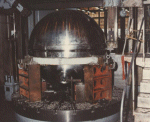 |
52k | The personnel sphere in the machine shop for back-machining of the girth weld prior to nondestructive testing (NDT) X-Ray testing of the weld deposit. A side note; the two hemispheres were welded using a double u groove weld prep for a full penetration weld. This girth weld was made by welding from both inside and outside of the sphere. Each weld pass had to be ultrasonic hardness tested to ensure there wasn't any surface contamination before the next weld pass was made. The weld thickness when completed would be the same as the thickness of the sphere. To ensure the quality of the weld, when 1/3 of the required weld thickness was completed, the sphere would be sent to the machine shop and about 1/8 inch of the weld thickness would be removed by machining and then the sphere would be sent to NDT for X-Ray of the weld. This process was repeated until the required weld thickness was completed. After all of the welding and machining was completed, the entire sphere was X-Ray'ed and 100% of the sphere surface was liquid penetrate(PT) inspected. This PT was looking for any surface flaws the could become stress risers, areas where sea pressure could cause a deformation in the surface of the sphere that could compromise the integrity of the sphere. Anyway, there was a lot of testing of the titanium materials and welds used to fabricate Sea Cliff (DSV-4). |
Photo & text courtesy of Jim Richardson. | |
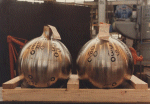 |
56k | Titanium Mercury Trim Tanks of the Sea Cliff (DSV-4). | Photo & text courtesy of Jim Richardson. | |
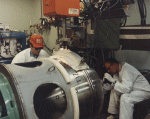 |
70k | Technicians using the mechanized hot wire Gas Tungsten Arc Welding (GTAW) process developed at Mare Island for welding thick section of titanium. What Makes Titanium Welding Different? Titanium is readily welded using the Gas Tungsten Arc Welding (GTAW) process. However, titanium is a highly reactive metal that is extraordinary sensitive to contamination during the fabrication process. Titanium readily absorbs certain elements and integrates them into the metal's micro-structure. The most detrimental atmospheric elements regarding titanium are oxygen, hydrogen, and nitrogen, are called interstitial elements. Carbon is also an interstitial element of concern during titanium fabrication. These elements can affect the metals properties at temperatures at or above 500°F. Other elements affect the metal's properties from the breaking down of certain compounds during the welding process. Halogens (astatine, fluorine, chlorine, bromine, and iodine) are detrimental compounds that collect as surface contamination from typical fabrication, handling, machining, cleaning, and environment sources. Examples are hydrocarbons (e.g. oil), chlorides (e.g. salt) and moisture. Hydrogen, Carbon and Oxygen absorption leads to a more brittle material. Chlorine absorbed by titanium at elevated temperatures can result in stress corrosion cracking. For these reasons cleaning solvents used on titanium are required to be non-halogenated. Cutting fluids used for machining should be water based (water will not entrap itself on the metal surface). All of these concerns are critical at temperatures at and above 500°F. The only evidence that a loss of mechanical properties resulting from the absorption of oxygen, nitrogen, and hydrogen or carbon has occurred is the presence of an oxide film on the weld surface. This potential for brittle welds is the reason that titanium requires complete argon shielding of all areas that exceed 500°F in addition to argon supplied by the welding torch. |
Photo & text courtesy of Jim Richardson. | |
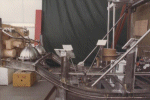 |
37k | Pictured here is the forward end of the titanium frame with the four mounting pads that the personnel sphere will be attached to. Also in the photo are the mercury trim tanks installed.
|
Photo & text courtesy of Jim Richardson. | |
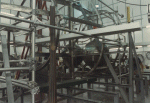 |
72k | Another view of the titanium frame during fabrication. The two titanium spheres in the photo are the high pressure air flask. | Photo & text courtesy of Jim Richardson. | |
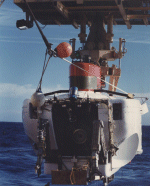 |
70k | Sea Cliff circa early 1980's following it's initial upgrade operating depth of from 6,500 feet to 20,000 feet. At that depth, Sea Cliff is capable of reaching 98 percent of the world's ocean floor, an area roughly six times that of the surface of the moon. As a result, Sea Cliff enjoyed the distinction of being named flagship for the "Year of the Ocean" in 1985. | Text courtesy of chinfo.navy.mil. Photo courtesy of Jim Richardson. Note: The contributor of the majority of the photos on this page, Jim Richardson, worked at Mare Island Naval Shipyard during the conversion and was very involved in the rebuilding of Sea Cliff (DSV-4) to increase her operations to a depth of 20K. | |
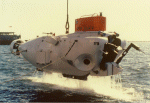 |
161k | Sea Cliff (DSV-4) in the spring of 1984 (late March or early April)in San Diego. Sea Cliff had returned to San Diego from the 20K conversion in Mare Island in February. This was one of the early test "dunks" in San Diego Bay off the Quay Wall at NASNI, one of many prelude tests leading up to sea trials. Key indicators are: Single Point lift fitting, Ascent/descent weight dropper (mid body under the stbd side pod), anti-entanglement rig on the side pod, the black painted manipulators and the new 20K logo visible on the aft corner of the sail. I was engineer officer on Sea Cliff from October 81 - July 84 and went through the conversion at MI, the follow on testing and sea trial period and her first operational series in May-June 84. A series of dives to recover debris and assist in the accident investigation following the crash of a USMC CH-53 helicopter off the west coast of San Clemente Island. |
Photo i.d & text courtesy of Patrick O'Brien. USN photo courtesy of Darryl L. Baker. | |
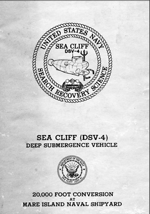 0835454 |
847k | 5 page PDF Welcome Aboard pamphlet of the Sea Cliff (DSV-4), circa 1985. | Courtesy of Darryl L. Baker. | |
 0835423 |
487k | Cargo Door Assembled Interior from United Airlines Flight 811 from Los Angeles to Sydney, with intermediate stops at Honolulu and Auckland. On 24 February 1989, the Boeing 747-122 serving the flight experienced a cargo-door failure in flight at 22,000 feet shortly after leaving Honolulu. The resulting explosive decompression blew out several rows of seats, killing nine passengers. The aircraft returned to Honolulu and landed with no further incident. The Sea Cliff (DSV-4) recovered the door at a depth of 14,000 feet. |
Photo courtesy of wikimedia.org | |
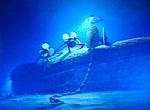 | 107k | MV Laney Chouest transporting Sea Cliff (DSV-4) enroute to Savo Island where she would dive over sunken battleship Kirishima in Ironbottom Sound, at a depth of 3,000 feet in 1991. | Photo courtesy of nationalgeographic.com via Tommy Trampp. | |
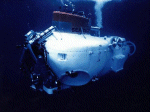 |
52k | Sea Cliff (DSV-4), submerged off Guadalcanal, at Iron Bottom Sound, 1 August 1992.
|
Text courtesy of Dave Reid. Photo by LCDR (Retired) Dan Butler. (Copyright), courtesy of Federation of American Scientists, fas.org. | |
 |
48k | Postal cover marking the dive of the Sea Cliff (DSV-4), at Iron Bottom Sound off Guadalcanal, with Prof. Robert Ballard, while filming a National Geographic Special, 1 August 1992. | Courtesy of Jack Treutle (of blessed memory). | |
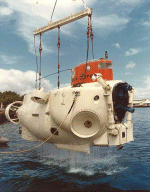 |
51k | Sea Cliff (DSV-4), being raised by her support ship. Date and location unknown. The following text was provided by Jim Richardson on the event of her 1000th dive. Sea Cliff Milestone Date: Wednesday, 20 September 1995 To All Who Have Been involved with Sea Cliff Over the Years, Message was received from Commodore Durham, CSDG 1 on 19 September 1995, that Sea Cliff completed its 1,000 dive during the West Coast National Undersea Research Program (NURP) Operations at Main Endeavor Hydrothermal Field on the Juan De Fuca Ridge. Text of Message: "1. TODAY SEA CLIFF REACHED A MAJOR MILESTONE IN 26 YEARS OF SERVICE BY COMPLETING DIVE NUMBER 1,000. NAMED FOR A SMALL TOWN IN NEW YORK, SEA CLIFF WAS BUILT BY ELECTRIC BOAT AND WAS LAUNCHED ON 11 DEC 1968. AFTER COMPLETION OF INITIAL NAVY ACCEPTANCE TESTING, SEA CLIFF WAS ASSIGNED TO SUBMARINE DEVELOPMENT GROUP ONE. DURING THE NEXT 14 YEARS, SEA CLIFF CONDUCTED MISSIONS TO DEPTHS OF 6500 FEET. IN JUNE 1983, MARE ISLAND NAVAL SHIPYARD BEGAN AN EXTENSIVE PROJECT WHICH CONVERTED SEA CLIFF TO A SUBMERSIBLE CAPABLE OF REACHING DEPTHS OF 20,000 FEET. WITH THE RETIREMENT OF Trieste II IN MARCH OF 1965, SEA CLIFF BECAME THE WORLD'S DEEPEST DIVING MANNED SUBMERSIBLE AND REMAINS THE NAVY'S PRINCIPLE DEEP OCEAN SEARCH AND RECOVERY ASSET, CAPABLE OF REACHING 98 PERCENT OF THE WORLD'S OCEAN FLOOR. 2. SEA CLIFF'S EXCEPTIONAL PERFORMANCE DURING 1995 SET NEW RECORDS FOR MISSION RELIABILITY AND SUSTAINED OPERATIONS, CONSISTENT WITH HIGH SUBMARINE FORCE STANDARDS. THESE ACHIEVEMENTS REFLECT THE DEDICATION AND PROFESSIONALISM OF THE MEN AND WOMEN ASSIGNED TO SEA CLIFF THE STRONG AND PROFESSIONAL DEEP SUBMERGENCE PROGRAM SUPPORTING CAST HEADED BY NAVSEA. CONGRATULATIONS AND WELL DONE! |
Photo courtesy of ussubvetsofwwii.org | |
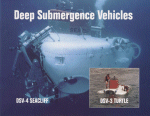 |
2.40k | 19 page PDF Booklet about the Turtle (DSV-3) & Sea Cliff (DSV-4) & published 31 March 1996. | Courtesy of NAVSEA, submitted by Jim Richardson. | |
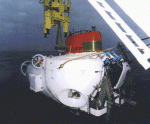 |
52k | Sea Cliff (DSV-4) | Photo courtesy of Federation of American Scientists, fas.org. | |
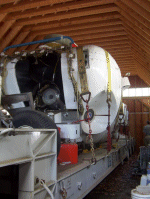 |
179k | Sea Cliff (DSV-4) in storage at Woods Hole,Mass., 2005.
|
Photo courtesy of David Reid. Photo i.d. courtesy of David Sims, Science Support Tech, Woods Hole Oceanographic Institution. | |
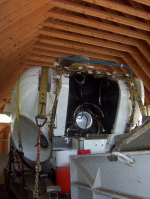 |
173k | Sea Cliff (DSV-4) in storage at Woods Hole,Mass., 2005.
|
Photo courtesy of David Reid. Photo i.d. courtesy of David Sims, Science Support Tech, Woods Hole Oceanographic Institution. | |
| Back To The Main Photo Index | Back To the Submarine Index |
|
Problems and site related matters, E-mail Webmaster |
|
This page is created and maintained by Michael Mohl. All Pages © 1996 - 2025 NavSource History. All rights reserved. |